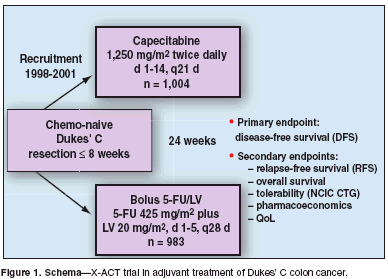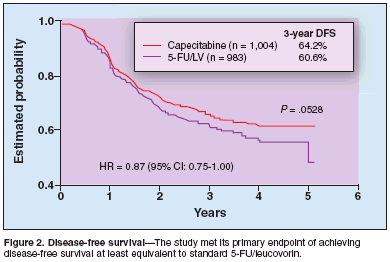Capecitabine Equal to Bolus 5-FU/LV in Adjuvant Therapy for Colon Cancer
This special “annual highlights” supplement to Oncology News International (ONI)is a compilation of selected news on important advances in the management ofgastrointestinal cancers over the past year, as reported in ONI. Guest Editor, Dr.James L. Abbruzzese, comments on the reports included herein and discussesdevelopments in the clinical management of GI cancers, with a look at the impactof targeted agents with cytotoxic chemotherapy, first-line and adjuvant therapies foradvanced disease, and the role of statins and COX-2 inhibitors in prevention.
NEW ORLEANS-As adjuvanttherapy for colon cancer, oral treatmentwith capecitabine (Xeloda) is atleast equivalent to an intravenouslyadministered bolus of 5-fluorouracilplus leucovorin (5-FU/LV), the longtermstandard of care. This is the principalconclusion drawn from the phaseIII X-ACT Trial (Xeloda in AdjuvantColon Cancer Therapy).Jim Cassidy, MD, of the Universityof Glasgow, Scotland, presented theresults at the 40th Annual Meeting ofthe American Society for Clinical Oncology(abstract 3509). "In my opinion,"Dr. Cassidy said, "capecitabineshould replace bolus 5-FU/LV in theadjuvant treatment of Dukes' C coloncancer."The multicenter trial, involving investigatorsin 164 centers, enrolled1,987 patients with resected Dukes' Ccolon cancer. Within 8 weeks of tumorresection, patients were randomizedto oral capecitabine (1,250 mg/m2 twice daily for 14 days, every 3weeks) or to the Mayo Clinic regimenof intravenous 5-FU/LV (5-FU 425mg/m2/LV 20 mg/m2 days 1 to 5, every4 weeks); treatment continued for 24weeks, for a total of eight cycles ofcapecitabine and six cycles of 5-FU/LV.Patients were followed for a medianof 3.8 years. In both groups, thegreat majority completed the fullcourse of treatment (84% in thecapecitabine arm vs 88% in the 5-FU/LV arm), although dose managementwas required, with 57% of capecitabinepatients and 52% of 5-FU/LVpatients requiring dose reduction, delay,or interruption at some point duringthe trial. Dr. Cassidy pointed outthat the oral formulation of capecitabinewas particularly advantageous infacilitating this dosage management,permitting patient involvement inmaintenance of the protocol.


The principal endpoint was disease-free survival (relapse-free survivalplus all deaths from other causes),with the aim being to demonstratethat oral capecitabine was at least equivalent in efficacy to 5-FU/LV; inaddition, secondary efficacy measuresincluded overall survival and relapsefreesurvival (relapses or new coloncancer plus all deaths due to coloncancer or treatment).In the intent-to-treat analysis, disease-free survival with capecitabine was not only equivalent to 5-FU/LV,but at 3 years showed a definite trendtoward superiority-64.2% vs 60.6%,hazard ratio (HR) 0.87-almost reachingstatistical significance (P = .0528).This was confirmed in the per-protocolpopulation, in which the hazardratio for disease-free survival for patientson capecitabine was 0.89.Superior Relapse-Free SurvivalSimilar treatment-related differences,in favor of capecitabine, werealso observed in the intent-to-treatanalysis for 3-year relapse-free survival(65.5% vs 61.9%, HR = 0.86), whichwas significant at P = .0407, and overallsurvival (81.3% vs 77.6%, HR =0.84, P = .0706). Subgroup analysisalso confirmed the superiority ofcapecitabine, irrespective of gender,age group, nodal status, and level ofcarcinoembryonic antigen (CEA).Oral capecitabine also showed animproved safety profile, comparedwith the traditional 5-FU/LV regimen,with significantly fewer adverse eventsin nearly all categories, including diarrhea,stomatitis, neutropenia, nauseaand vomiting, and alopecia (P
Newsletter
Stay up to date on recent advances in the multidisciplinary approach to cancer.
Elevating the Quality of Cancer Care Via Cross-Department Collaboration
Experts from Sibley Memorial Hospital discuss how multidisciplinary work has enhanced outcomes such as survival and resource use at their institution.